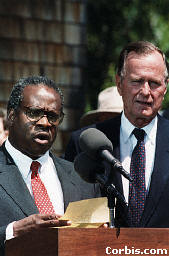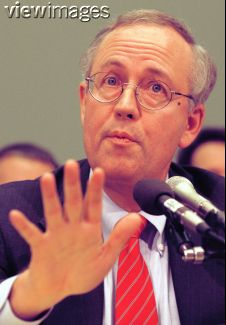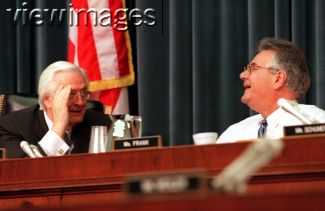May 2
Law and Politics in the 1990s

Ronald Reagan nominating Robert Bork for a Supreme Court vacancy, 1987
| Given the increasing links between law and politics, there is little surprise that the ultimate point of intersection between the two phenomena--Supreme Court appointments--has grown more controversial. Since 1968, six Supreme Court nominees (Abe Fortas, Homer Thornberry, Clement Haynsworth, G. Harrold Carswell, Robert Bork, and Clarence Thomas) have faced divisive confirmation fights; only Thomas ultimately received Senate approval. |
| But this issue became much more prominent in the 1980s and early 1990s. In a way, the Bork and Thomas confirmation battles were forerunners of the 1990s "trials of the century"--OJ Simpson, Rodney King, and others--in which the judicial arena became the setting for a broader social commentary on important issues in American life. In the case of Bork, abortion and civil rights were the key issues; the Thomas confirmation was dominated by the vagaries of racial politics and the boundaries of sexual harassment. With the Democrats possessing a 14-seat majority in the Senate, a determined grassroots campaign by women's groups and especially civil rights activists--along with Bork's many writings, in which he attacked, among other things, the constitutionality of Roe and the 1964 Civil Rights Act--helped send the nominee down to defeat by an overwhelming 58-to-42 vote. The less conservative Anthony Kennedy ultimately replaced Bork as President Reagan's selection. |
| In many ways, the Thomas battle contained more long-term importance than the Bork fight. President George Bush's first nominee was the moderate David Souter. But Thomas, who had compiled a strongly conservative record on the bench and in working as Ronald Reagan's director of EEOC, was nominated to replace the Court's most liberal member, the gravely ill Thurgood Marshall. Although Bush claimed that Thomas was selected because "he is the best person for this position," Thomas's status as an African-American conservative clearly entered into the equation. |

President Bush introducing Judge Thomas |
| From September 10 through 20, 1991, the Senate Judiciary Committee conducted intensive hearings that focused on Thomas's rather slim qualifications and conservative views; Thomas himself testified for five days, while a variety of liberal groups spoke in opposition. On September 27, the Judiciary Committee voted 7 to 7 on Thomas's nomination, thus sending the issue to the full Senate without the committee's endorsement. | |
 Anita Hill before the Senate Judiciary Committee |
Before that vote could be scheduled, however, National Public Radio's Nina Totenberg broke the story that a former assistant to Thomas, University of Oklahoma law professor Anita Hill, had charged that Thomas had sexually harassed her. On October 11, the Judiciary Committee re-opened the hearings, inviting testimony from Hill and Thomas. Public opinion nationwide was divided over which person to believe: Thomas described the affair as a "high-tech lynching" of an "uppity black" who thought for himself, while Hill's supporters cringed at the harsh questions she received from an all-white, all-male committee. On October 15, the full Senate began debate on the nomination; the next day, by a 52 to 48 margin, the upper chamber voted to confirm Thomas as an associate justice of the Supreme Court. |
Aftermath:
The hearings left a polarized country in their wake. The media came under strong--and, in many ways, justified--attack for its handling of the affair. More important, the Senate's response to Hill galvanized women's political groups, who had suffered a series of setbacks during the Reagan years. In Illinois, Cook County Clerk Carol Mosely-Braun challenged incumbent Democratic senator Alan Dixon after Dixon voted for Thomas; in a stunning upset, Mosely-Braun captured the Democratic nomination and became the first African-American woman ever elected to the Senate. In Washington, a little-known state senator, Patty Murray, defeated a former congressman in the Democratic primary and a sitting congressman in the genera election to become the first woman senator from her state. And in California, which had two open Senate seats, Democrats Barbara Boxer--a graduate of Brooklyn College--and Dianne Feinstein swept to victory in the fall. Their election, combined with the public reaction to the hearings, brought renewed attention to the issue of sexual harassment in Washington, and Congress in the early 1990s passed several pieces of legislation strengthening sexual harassment laws. Thomas, meanwhile, has compiled a strongly conservative voting record since joining the Court.
 Independent Counsel Kenneth Starr, testifying before the House Judiciary Committee |
 Judiciary Chairman Henry Hyde (R-Illinois) with the committee's most effective Democrat, Barney Frank of Massachusetts. |
The intersection between law and
politics, however, has grown only more intense over the last 10 years--and
reached its nigh points in 1998, with Clinton's impeachment, and 2000,
with the disputed election. Impeachment first. You can begin with a
timeline of the impeachment proceedings, along with a
sampling of House
debate on impeachment. Although without transcripts, this nonetheless
provides a good sense of the tense atmosphere in the House during the
proceedings. Given the recent nature of the Clinton impeachment, it is
difficult to address in a historical framework. But not impossible. First
of all, two excellent
books on the impeachment--by Jeffrey Tobbin and Richard
Posner--provide some broader grounding of the affair. Second, the
Clinton/Lewinsky affair provides an opening for some interesting
historical questions, namely:
|
Impeachment, of course, represents only one avenue of judicial or quasi-judicial investigations of the executive since Watergate. Most such investigations have centered on the Office of Independent Counsel, one of the more controversial creations of the Watergate-era Congress. This interesting site provides a history of the law along with a start-to-finish coverage of one high-profile independent counsel investigation.

The nine justices who decided Bush v. Gore. From left to right,
Justices Thomas, Scalia, O'Connor, Kennedy, Souter, Breyer, Stevens, Rehnquist,
and Ginsburg
| In their complaints against the Warren Court, conservatives advocated a philosophy of "strict constructionism," under which Supreme Court Justices would interpret the law according to the mandates of the Framers. In the modern world, however, that has proven an elusive goal, and the Rehnquist Court has been as interventionist as its 1960s predecessor, except with a different ideological bent. Three themes that we have been studying over the past few weeks--the politicization of the Supreme Court, the growing use of the law by grassroots groups, and the impact of presidential scandal--all came together in the election of 2000. An extraordinarily close and bitter contest, in which both Republican George Bush and Democratic Al Gore used the character of their future Supreme Court appointees as an issue, culminated in a virtual tie on Election Night. After the votes were counted, less than 1,000 votes separated the two men in Florida, whose electoral votes would decide the election. |
| It soon became clear that the courts would decide the winner. The Gore squad demanded a hand recount of the ballots in several Democratic counties; the Florida secretary of state, Republican Katherine Harris, seemed to go out of her way to impede the progress of these counts; and so Gore's forces went to court. They twice won victories before the Florida Supreme Court to extend the deadline for counting the ballots, only to have the Supreme Court intervene in a highly controversial 5-to-4 decision that terminated the recounting and ensured a victory for Bush. The decision, which seemed to contradict the Rehnquist court's preference for federalism and rested on an unusual interpretation of the equal protection clause, provoked widespread criticism from liberals and even from some conservatives; it also generated bitter dissents from Justices John Paul Stevens and Ruth Bader Ginsburg. |
| But, for sheer political drama, little can match the final hearing before the Supreme Court, and the audio, along with real-time transcripts, is available; click on Bush v. Gore after arriving on the Oyez site. The hearing lasted 2 hours; given the importance of the question and the rare contemporary release of Supreme Court audio material, it is worth the effort to at least take a small listen. |
Has the Supreme Court survived its intervention in the political process? Commentator Charles Krauthammer argues that it has; USA Today legal reporter Tony Mauro is less certain.